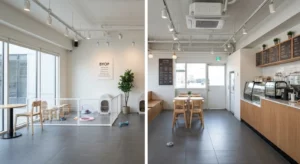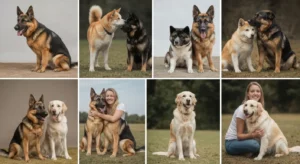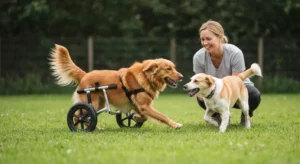When I first signed the lease for my tiny, 500-square-foot apartment in the city, my heart sank a little. I looked around at the small living room, the galley kitchen, and the distinct lack of a backyard, and I thought my dream of having a dog would have to be put on hold. For years, I’d poured my heart into volunteering at local shelters and working as a vet tech, surrounded by animals. The thought of my own home being dog-less felt impossibly quiet and empty.
But over the years, through my own experiences and by watching friends, neighbors, and the hundreds of families I met at the shelter, I learned a powerful truth: a loving home for a dog isn’t about square footage. It’s about commitment, understanding, and choosing a companion whose needs align with your lifestyle. An apartment can be a palace for the right dog.
This isn’t just a list of small dogs. This is a collection of stories and hard-won lessons about the breeds I’ve come to know and love, who have proven time and again that they are some of the best apartment dog breeds out there. Let me introduce you to a few of them.
-
The Bichon Frise: My Fluffy, Allergen-Free Roommate
I was fostering a little Bichon Frise named Pip, and my building had a strict “no-barking” policy that had me sweating. Pip was a little white puffball of pure energy and joy, and I was terrified his excitement would get us both evicted. I pictured him yapping at every sound in the hallway of my high-rise.
What surprised me was his intelligence. Bichons are often pegged as just cute fluff, but Pip was sharp. We worked on “quiet” commands from day one. The real game-changer was how he channeled his energy. He wasn’t interested in endless running; he was interested in people. His “job” became greeting our neighbors in the hallway. He’d sit patiently, give a happy little butt-wiggle, and soak up the attention. He satisfied his social needs without making a peep.
My takeaway for you: A Bichon’s needs are more social than spatial. If you can provide them with plenty of interaction, puzzle toys, and consistent training, they are marvelously adaptable. And as a bonus for my own allergies and my vacuum cleaner, that “hypoallergenic” coat was a genuine lifesaver.
-
The Cavalier King Charles Spaniel: The Ultimate Lap-Warmer
I never owned a Cavalier myself, but I was the designated sitter for my elderly neighbor’s dog, a sweet, doe-eyed tri-color named Arthur. Arthur’s entire world was the space between the front door, his food bowl, and my neighbor’s lap. He was the definition of a companion dog, bred for centuries to do exactly what he did best: love his person.
When I’d watch him, he’d follow me from the kitchen to the living room, not with anxious energy, but with a calm, devoted presence. He’d curl up on my feet while I worked from home, his soft snores the only sound in the room. His daily exercise requirement was a leisurely stroll to the end of the block and back, where he’d sniff one specific fire hydrant with the focus of a bomb-sniffing dog before deciding it was time to go back upstairs for a nap. He didn’t need a yard; he needed a warm body to lean against.
My takeaway for you: If your ideal afternoon involves a book, a blanket, and a dog snoring softly beside you, the Cavalier is your soulmate. They are gentle, affectionate, and have a very low prey drive. However, be prepared for their health issues (especially heart conditions) and find a fantastic vet. Their love is boundless, but they require diligent care.
-
The Greyhound: The 45-MPH Couch Potato
This is the one that surprises everyone. “A Greyhound in an apartment? Aren’t they racing dogs?” I heard it all the time at the shelter where I volunteered with a greyhound rescue group. Then I’d introduce them to Stella.
Stella was a retired racer, a sleek, brindle beauty with soulful eyes. In her kennel, she was reserved and quiet. When we took her out, she walked politely on the leash, never pulling. But the first time we took her to a secure, fenced-in dog park, we saw it. She exploded in a lap of pure, unadulterated joy—a “zoomie” that lasted all of 30 seconds. And then… she was done. She trotted over, leaned against my legs, and was ready for her five-hour nap. That was her daily exercise, done and dusted.
My takeaway for you: Greyhounds are built for sprints, not marathons. They are surprisingly low-energy indoors and are often called “giant cats” for their love of napping in soft places. If you can provide a daily opportunity for a short, safe sprint and a comfy couch, you’ll be rewarded with a serene, graceful, and incredibly sweet companion.
-
The French Bulldog: A Clown in a Philosopher’s Body
My best friend has a Frenchie named Gus, and living with Gus is a constant source of comedy. He is stubborn, opinionated, and communicates exclusively through a series of snorts, grunts, and dramatic sighs. He doesn’t need much space because, frankly, he can’t be bothered to use it. His favorite activities are sunbathing in the single patch of light that hits the apartment floor and sleeping on his back with all four paws in the air.
But Gus taught me a crucial lesson about responsible ownership of a brachycephalic (flat-faced) breed. During a summer heatwave, a simple walk around the block became a serious risk. My friend had to get creative with indoor games, puzzle feeders, and a cooling mat to keep him stimulated and safe. He’s a perfect apartment dog, but his well-being is completely dependent on a climate-controlled environment.
My takeaway for you: Frenchies are charming, low-energy, and hilarious. But you must be prepared for their health needs. They don’t tolerate heat, can have breathing issues, and are prone to allergies. They are an absolute delight, but they are not a low-maintenance breed when it comes to their health.
-
The Pug: So Much Personality in a Wrinkly Package
During my time as a vet tech, I fell head-over-heels for a fawn Pug named Winston. He was a little loaf of bread with a tail, and he’d follow his owner around the clinic with an adoring gaze, snorting happily with every step. He was the quintessential apartment dog: content, people-oriented, and perfectly happy with city life.
But I also saw the other side. I had a gentle but firm conversation with Winston’s owner about his weight, which was creeping up, and the importance of keeping his deep facial wrinkles clean to prevent infections. Pugs live to eat, and in an apartment setting where long-distance runs aren’t happening, it’s incredibly easy for them to become overweight, which puts a huge strain on their already-compromised breathing.
My takeaway for you: A Pug’s love is immense, but so is their appetite. Their charm is undeniable, but it comes with a responsibility to manage their diet strictly and perform daily hygiene on their facial folds. For the right owner, they are a treasure.
-
The Shih Tzu: The Imperial Lap Dog
Miko was my first-ever dog as an adult. I lived in a shoebox of a studio apartment, and I chose him because everything I read said Shih Tzus were bred for one purpose: to be companions in Chinese palaces. My studio was no palace, but Miko didn’t seem to notice. He treated my worn-out IKEA rug like a royal tapestry.
He was not a fan of long walks. He’d humor me for a block, do his business, and then plant his little feet, looking up at me as if to say, “Alright, I’ve seen the world. Let’s go back to the couch.” The biggest commitment with Miko wasn’t exercise, it was grooming. I learned to brush him daily to prevent mats, and our grooming sessions became a quiet, bonding ritual that I came to cherish. He taught me that caring for a dog isn’t just about walks and playtime; it’s also about these moments of gentle, focused care.
My takeaway for you: If you’re looking for a dog that is truly a low-energy homebody, the Shih Tzu is a top contender. Just be prepared for the commitment of daily grooming or the expense of a professional groomer every 4-6 weeks. They are living, breathing, shedding teddy bears.
-
The Basset Hound: A Low-Energy Dog with a High-Volume Voice
Okay, this one is a bit of a cautionary tale wrapped in affection. My downstairs neighbor had a Basset Hound named Barnaby, and I knew exactly when his owner left for work. Barnaby had a bay—a deep, mournful, soulful “ARROOOO”—that could penetrate concrete. He was a classic low-energy dog, perfectly content to snooze the day away, but his separation anxiety was LOUD.
I watched my neighbor work tirelessly to solve the problem. He used puzzle feeders filled with frozen peanut butter that took Barnaby 30 minutes to conquer. He worked on crate training in tiny increments, and he started leaving the TV on. Slowly but surely, the morning concerts became shorter and eventually stopped. Barnaby was perfectly happy in the apartment; he just needed his brain to be as tired as his body.
My takeaway for you: A Basset Hound’s energy level is perfect for an apartment, but their potential for noise is not. Do not get a Basset Hound if you cannot tolerate barking or are unwilling to put in serious work on separation anxiety training from day one. For a patient owner, they are the most lovable, droopy-eared companions imaginable.
-
The Maltese: The Fearless Little White Mop
In one of my dog training classes, there was a tiny Maltese named Lola who weighed maybe six pounds soaking wet. She had a pristine white coat and a sassy little topknot, but the attitude of a Rottweiler. She was fearless, smart, and utterly devoted to her owner, who lived in a small condo.
What I found fascinating was how her owner handled the challenges of a tiny dog in a big city. During a particularly brutal winter, taking Lola out for potty breaks was miserable for them both. So, her owner trained her to use an indoor potty station with a patch of artificial turf. It was a brilliant solution that kept Lola safe and warm. It proved that with a little creativity, almost any challenge of apartment living can be overcome.
My takeaway for you: Maltese are portable, intelligent, and surprisingly hardy. They can be prone to “Small Dog Syndrome” if not properly socialized, so treat them like a real dog, not an accessory. Their small size makes them incredibly adaptable to creative apartment solutions, like indoor potty areas.
-
The Coton de Tulear: The Playful Court Jester
I met my first Coton de Tulear, Zuzu, at a pet-friendly cafe. This little white dog, a relative of the Bichon and Maltese, had a personality all its own. Cotons are known for being “clownish,” and Zuzu lived up to it. She would walk on her hind legs, cock her head in the most endearing way, and make little grunting noises to get attention.
Her owner told me that living in an apartment was easy because Zuzu’s playful nature wasn’t destructive. She didn’t need to run for miles; she needed to play a game of hide-and-seek in the living room or learn a new trick. She was incredibly bright and eager to please, and that mental stimulation was just as tiring for her as a long run would be for a different breed. She was happy, engaged, and perfectly content in her small kingdom.
My takeaway for you: The Coton de Tulear is a fantastic choice if you want a playful, interactive companion who doesn’t require a ton of outdoor exercise. They bond very closely with their families and can suffer from separation anxiety, so they’re best for households where someone is often home. Be ready to be entertained!
Living in an apartment never stopped me from filling my life with the love of a dog, and it shouldn’t stop you either. The key is honesty. Be honest about your space, your schedule, and the energy you can truly provide. The perfect canine roommate is out there waiting for you, and they care a lot more about the size of your heart than the size of your home.












